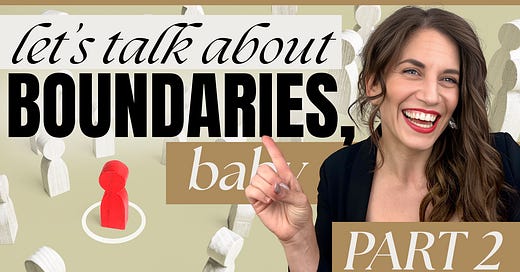Setting boundaries is easy. Sticking to them? That’s where things get messy.
Ever felt guilty for enforcing your needs?
Had someone push back when you tried?
Or maybe you keep bending your own boundaries (even when you know you shouldn’t)?
The truth is, boundaries only work if you know how to reinforce them, adapt when needed, and call out violations without guilt or drama. Learn how to keep your relationships—monogamous or non-monogamous—healthy, balanced, and built to last.
Ready to make non-monogamy work for you? Get my course ENM 101 and build a Relationship Agreement that keeps your love life hot and your boundaries locked in.
If you think boundaries are just a ‘polyamory thing’—think again. Because here’s the truth: No matter what kind of relationship you’re in, if you don’t talk about boundaries, you’re basically driving without a GPS. And let’s be real—how well does that usually work out?

Hi! I’m Ally Iseman! I’m a relationship coach and I want you to have the tools and skills you need to build the relationships you want and deserve. I share all the lessons I’ve learned the hard way, so you don’t have to!
Last week we talked about what boundaries are, common misconceptions, all the different types of boundaries that show up in all kinds of relationships–monogamous or non-monogamous–why they matter, and what happens when we don’t set them.
But how do we set them?
Let’s be honest, most people don’t grow up learning this stuff. Raise your hand if your family modeled “just suck it up” instead of “express your needs.” ✋
So let’s talk about...
How to Create Boundaries That Actually Work

Step 1: Know Thyself
Boundaries aren’t one-size-fits-all. You’re not doing anyone any favors by copying someone else’s boundaries instead of figuring out what actually works for you. Before you set boundaries, you need to ask yourself:
What behaviors make me feel safe, respected, and valued?
What situations make me feel anxious, drained, or resentful?
What am I willing to compromise on, and what’s non-negotiable?
What do I need to be happy in this relationship?
For example: If you notice that last-minute plan changes stress you out, you might need a boundary around giving advance notice.
Once you’re ready to communicate your needs and expectations to your partner or partners, do so clearly and assertively. Make sure to use "I" statements to focus on your feelings and preferences:
“I need time to process before big conversations,” instead of “You always spring heavy talks on me.”
Be direct but kind: Boundaries are about your needs, not blaming the other person.

Step 2: Communicate Clearly (and Early!)
The most common mistake I’ve seen is when boundaries are created reactively, only after something goes wrong. Don’t wait until things get messy—have the conversation early and often.
Think of boundaries like a relationship seatbelt—you don’t put them on after the crash.
Since we’re not really taught preventative skills like this, especially in our relationships, it’s easy to feel like someone’s done something wrong when that’s what you’re trying to avoid in the first place!
Make sure you’re framing the conversation as an invitation to take care of something you both care about: each other.
“I want to make sure we’re both on the same page about what makes us feel respected in this relationship. Can we talk about it?”

Step 3: Make Them Flexible, Not Rigid
Boundaries can evolve as you and your relationships grow. They’re not hard fixed points, they’re just the edges of our comfort zone. Designed to be pushed–consensually and in a safe environment–in order to promote personal growth.
For example: Maybe at first you needed daily check-ins, but over time, you realize weekly check-ins work better.
The key: A healthy boundary = something that protects you without controlling your partner.
RULE
“You’re not allowed to have friends of the opposite sex.”
BOUNDARY
“I feel safe when we communicate openly about our friendships.”
Be ready for pushback and stick to your boundaries anyway! Not everyone will like your boundaries—especially if they’ve benefited from you not having them.
Some common reactions to new boundaries can be:
Guilt-tripping: “But I always did this before, why are you changing now?”
Testing the boundary: “I know you said no last-minute plans, but this time is different…”
Anger or withdrawal: Especially if someone isn’t used to you standing up for your needs.
If you run into any of these, stay calm and repeat your boundary without over-explaining.
“I understand that this is different from before, but this is something I need now to feel good in our relationship.”
If they consistently disrespect your boundary? That’s a sign they don’t respect you.
Have you ever had someone push back on a boundary you set? How did you handle it? Share your story with the community so we can all learn together!

How to Maintain Boundaries
So, you’ve set your boundaries—great! But now comes the real challenge: keeping them. Because boundaries aren’t a “set it and forget it” kind of thing. They need reinforcement, flexibility, and communication to actually work long-term.
Step 1: Check In Regularly
Your needs aren’t set in stone—like we already talked about, they can shift as you grow, as your relationship evolves, and as life changes.
Ask yourself periodically:
Does this boundary still feel right for me?
Has anything changed that requires a new conversation?
Am I actually honoring my own boundary, or am I slipping back into old habits?
Maybe when you first opened your relationship, you needed a strict rule about no sleepovers. But now, you feel more secure and realize that rule no longer serves you. That’s okay! Boundaries should evolve with your comfort level.
Step 2: Adapt As Needed
Boundaries aren’t meant to be rigid rules—they should be flexible when necessary. Just because you set a boundary once doesn’t mean it’s set in stone forever. Relationships evolve—so should your boundaries. Adapt them when needed—but do it intentionally.
It might be time to adjust a boundary if:
It’s causing more stress than peace.
It no longer aligns with your values or needs.
It’s harming the relationship instead of supporting it.
If it is time to adjust a boundary, make sure you have a conversation about it, don’t just suddenly change it without telling your partner and expect them to know!
It is always okay to pause and ask yourselves:
“Are our agreements still working for us?”
Step 3: Respect goes both ways
People take boundaries seriously when you take them seriously.
What weakens a boundary?
Saying, “I need alone time on Sundays” but then letting plans override it every week.
Setting a boundary, then caving the moment someone guilt-trips you.
Allowing “exceptions” so often that the boundary basically disappears.
What strengthens a boundary?
Sticking to it even when it’s inconvenient or uncomfortable.
Gently reminding people when they forget (“Hey, remember I need a heads-up before changes?”).
Holding yourself accountable. Are you upholding your partner’s boundaries, too? If you expect your partner to respect your boundaries, you need to respect theirs.
Step 4: What if a boundary is crossed?
A boundary isn’t just something you say—it’s something you uphold. So make sure to be consistent in clearly communicating boundaries and holding your partners accountable by enforcing any related consequences for crossing them.
If your boundary is “I won’t stay in conversations where I’m being yelled at,” then the moment someone starts shouting, you remove yourself instead of engaging.
If a boundary is crossed, then it’s time to ACT:
Assess—was it a misunderstanding or an intentional violation?
Consider—does the boundary need to be adjusted, or is this a dealbreaker?
Take action—healthy boundaries require follow-through. If someone repeatedly disrespects them, that’s a huge red flag.
Boundaries in Monogamy vs. Non-Monogamy
No matter your relationship style, boundaries only work if they’re respected.
Monogamy
If you set a boundary around alone time, but your partner constantly expects you to be available, that’s a problem.
Polyamory
If you have a boundary about discussing new partners before things get physical, but your partner keeps telling you after the fact, that’s an issue.
If someone continuously ignores your boundary, it’s no longer an accident—it’s a sign of disrespect. We all make mistakes, but the same mistake repeated over time? That’s a behavioral issue that needs to be addressed.
The first time a boundary is crossed, a gentle reminder is enough:
“Hey, remember when I said this was important to me?”
Once you start experiencing repeated violations, it’s time to reiterate with consequences:
“I need to know my boundaries are respected. If this keeps happening, I’ll need to rethink how we move forward.”
And if we’re talking big violations? It may be time to reevaluate the relationship.
What’s one boundary you set that totally changed your relationships for the better?
If you need help creating and enforcing your own boundaries and relationship agreements, make sure to check out my course ENM 101.
No matter what relationship style you’re in, this is an important process that supports any and every relationship style.
Or you can just, you know, continue trying to read each other’s minds. How’s that working out for ya?
If you want more no-BS relationship advice like this, hit that subscribe button—I’ve been ENM since 2016 so ya know there’s plenty more where this came from!
💗 Please consider RESTACKING if you enjoyed this post💗
















Share this post